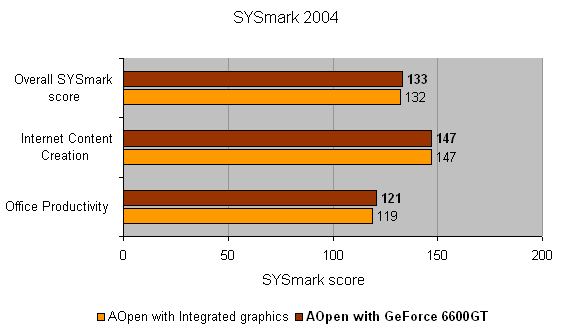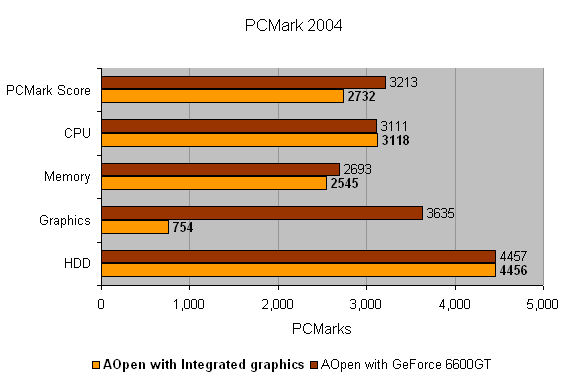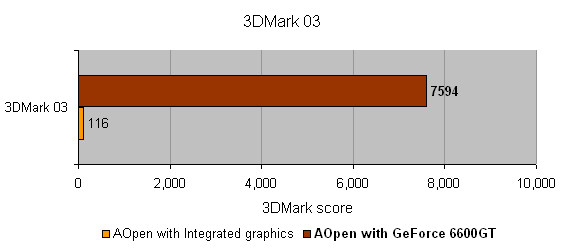AOpen i855GMEm-LFS – Pentium M Motherboard Review
AOpen i855GMEm-LFS – Pentium M Motherboard
Intel's Pentium M CPU is making a transition to the desktop - if you want a low power, quiet PC, this new board from AOpen could be the answer.

Verdict
Key Specifications
- Review Price: £145.00
With more home computers making their way into the living room, consumers are demanding quiet systems that don’t spoil the relaxed atmosphere. Trying to address this point, AOpen has produced a motherboard that should become very popular with anyone looking to build a low noise PC.
The cryptically named i855GMEm-LFS is a micro ATX motherboard based on the Intel 855GME chipset, which you would normally find in a laptop. In turn this means that the i855GMEm-LFS motherboard has to be used with a Pentium M processor.
The Pentium M is a low power chip, since it was designed for use in mobile computers. Consequently, the Pentium M produces less heat and therefore needs a smaller cooler with a relatively quiet fan. You won’t get the performance that you would from one of the latest desktop processors, but that’s a compromise you’ll have to make if you want a very quiet machine – unless you have enough money for a Hush PC. The Pentium M processors are however faster than the low clock speeds suggests, as the design is quite different from a Pentium 4.
You should be able to purchase a Pentium M CPU from several online retailers, but there is one downside to this setup, the processors are close to twice the price of a midrange Pentium 4 chip and the top of the range Pentium Ms cost well over £400. Expect to pay in the region of £180 for a 1.6GHz part, which sounds awfully expensive when you can get a 3GHz Pentium 4 for around £120. This aside AOpen has created a very interesting board, although AOpen is not the only manufacturer to have such a product in its line-up.
The i855GMEm-LFS might be a small motherboard but it’s packed with features that you wouldn’t expect to see on such a miniature platform. As the i855GME chipset only supports single channel memory there are only two memory slots and the board accepts up to 2GB of PC2100 or PC2700 DDR SDRAM. You also get integrated graphics, which will share anything from 4 to 32MB of system memory. This is fine for general Windows usage, but it lacks any real 3D performance.
This is not too much of a problem as there is an AGP slot, so if you plan to play the occasional game you can install your choice of 3D card to boost the performance. There are also three PCI slots in case you want to add some extra peripherals. Personally, I can see this board as a very good base for a home theatre PC, so a TV tuner card would be one obvious upgrade.
As the i855GME chipset doesn’t support SATA natively AOpen has fitted a Promise RAID controller, so you could have a RAID 0 or 1 configuration as long as you’re willing to have two hard drives in your PC. On top of this there is an Agere FireWire controller that adds two FireWire ports, but there is no bracket with any connectors, so unless your case has a front mounted FireWire connector, you won’t really get much use from this, unless you can lay your hands on a suitable bracket.
Amazingly, you also get two Marvell Gigabit Ethernet controllers onboard, although I’m not quite sure why AOpen decided to fit dual Gigabit Ethernet on an mATX board, but I guess if you really need a small and quiet server, with lightning fast networking, this feature would come in handy.
You also get on-board Realtek 5.1-channel AC97 audio, which does the job, but there’s no comparison to the latest HD audio solutions on the current crop of desktop boards. The remaining connectors on the I/O panel consist of two PS/2 ports, a serial and a parallel port, a D-SUB connector for the onboard graphics and four USB 2.0 ports.
General board layout is good, although the front audio connectors are at the rear of the board which means that you need to get a very long cable if your case has ports at the front. The same applies for the FireWire ports only in opposite – the headers are at the very front of the motherboard, so even if you find a rear bracket, you’ll have the cable draped across the board. The only other minor issue is that the memory slots are very close to the AGP slot, which means that you might have to remove your graphics card if you want to add more memory at a later stage – an annoyance, but not a major problem.
We don’t have any sound measurement equipment in the labs, but subjectively, it’s safe to say that this board is very quiet. The supplied CPU cooler is a low profile unit and it doesn’t even have a copper insert which is common place on pretty much all CPU coolers these days. The fan operates at a very low speed and you can control this further in the BIOS – AOpen’s SilentTek options give you far more advanced controls over the fan speeds than you would find on most other motherboards.
In terms of raw performance the i855GMEm-LFS won’t come anywhere close to a Pentium 4 desktop system, but this isn’t really the idea behind it. Although we only managed to get hold of a 1.6GHz Pentium M 725 processor with 2MB of cache to test it with, the motherboard will accept any Pentium M processor on a 400MHz bus.
The overall SYSMark 2004 score of 132 is hardly impressive, but there were no problems running the benchmark, which is always a good sign with new hardware. The PCMark 2004 scores were similar to those of notebooks we have tested in the past; with the only real difference being that the hard drive scores were much higher due to a desktop hard drive being used. The poor integrated 3D score proved that you won’t be able to play any recent games unless you install an AGP card. Throwing a GeForce 6600GT card into the mix, showed that you can expect numbers that aren’t miles away from those you’d get from a mid-range desktop PC.
The i855GMEm-LFS is an interesting board and I would think that it represents the beginning of a new trend; a trend that will become even more popular once Intel launches a PCI Express chipset for the Pentium M processor. Of course, the downside is the price you will have to pay for the processor and it doesn’t help that AOpen is expecting a not insignificant £144.85 for this board – considering that you can get an nForce 4 SLI board for less than this, you’re paying dearly for the sound of silence.
”’Verdict”’
The i855GMEm-LFS is the first in what will surely be a line of Pentium M based desktop products. There’s definitely a strong appeal for a small, low noise, low power machine, but you’ll need deep pockets.
(table:features)
The AOpen i855GMEm-LFS was tested using a Pentium M 725 1.6GHz processor, 512MB of PC3200 Adtec DDR SDRAM, an nVidia GeForce 6600GT and a Seagate 200GB Barracuda 7200.7 hard drive.



Trusted Score
Score in detail
-
Value 6
-
Performance 7

